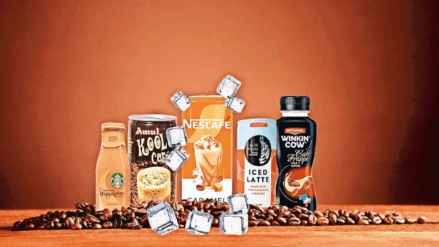Here’s a serious dilemma facing brands hawking indulgence products: Consumers want healthier formulations even when seeking gratification. The rapid rise of the ready-to-drink (RTD) coffee beverage category can be ascribed in part to this shift — while staying clear of the cola “sin”, it also offers convenience at a price point lower than that of made-to-order offerings from coffee shops such as Starbucks, Blue Tokai and Costa Coffee.
Nestlé’s recent arm flexing in the segment — it expanded its Nescafé ready-to-drink (RTD) portfolio last month with new caramel and chocolate flavours in “café-style” variants like mocha, latte, and cappuccino — signals it is ready to fight it out in supermarket aisles and convenience store fridges for a share of the `173-crore market growing at 10% year-on-year. Mind you, this is not Nescafe’s first shot at ready-made coffees — its Iced Lattes and Cappuccinos have been available in cans and single-use tetra packaging since 2016. Only this time, it has gone aggressive with display and packaging.
The timing for the portfolio expansion couldn’t have been more appropriate. Over the last two decades, the café culture has taken root in India led by urbanisation, higher disposable incomes, and global exposure. RTD coffee, once a novelty, is now becoming a serious business. Nisha Sampath, managing partner, Bright Angles Consulting points out that much of the groundwork was laid by early movers like Amul, whose Kool Café hit shelves in 2006. Aimed at the youth and priced for the masses, the product helped familiarise consumers with cold coffee as a packaged beverage. Dairy brands like Britannia followed suit, treating it as another flavour extension to their broader milk-based portfolio. But the true inflection point came with the entry of specialist players such as Bru and Nescafé, which segmented the market along formats and intensities.
“The growth of the RTD market in India can be connected to the change in work culture, urban development, and an increase in per capita income,” notes Sahil Arya, co-founder and director, Fat Tiger. “Gen Z and Millennials are embracing coffee not just as a drink, but as a lifestyle product — a trend shaped by social media, café aesthetics and global exposure.”
Globally, Nestlé has a wide RTD coffee portfolio. “For a large chunk of consumers, especially Gen Z and Millennials, cafés are their first exposure to cold coffee,” a Nestlé India spokesperson said. “While there is a sharp consumption skew during summer months, cold coffee is now relevant through the year.” The convenience of RTD formats, coupled with a growing demand for taste customisation and functional ingredients — such as low-sugar or added protein — is helping the category carve out a distinct identity.
Inevitably, competition is heating up. Global and homegrown brands alike — Starbucks with its bottled Frappuccino, new-age players like Rage Coffee and Sleepy Owl — are jostling for shelf space and consumer mindshare. Value-focused players are competing on price and reach, while artisanal names like Blue Tokai are catering to premium audiences with gourmet variants. The mid-premium space is where the fiercest competition now lies — balancing indulgence with affordability.
What unites them is a shared pursuit — weaning away the urban, mobile Indians from sugary sodas to chilled caffeine. “Young consumers seek products that blend health, taste, and visual appeal,” says Sahaj Chopra, co-founder and director, Juice Guys. “Packaging design, clean-label ingredients, and eco-friendliness now influence purchase decisions.” Smaller SKUs and deeper penetration into student populations and tier-2 markets could be the next frontier.
Despite its potential, India’s per capita coffee consumption lags behind global averages — just 70 gm annually compared to 5 kg in North America. India’s strong cultural affinity for tea, combined with regional taste variations, complicates the path to national scale. Pricing is another hurdle: RTD coffee typically costs more than carbonated drinks or fruit juices, and being milk-based, requires a robust cold chain to avoid spoilage.
In fact, no player seems to have cracked the pricing code. While Nescafé’s cafe-style coffee can retails from 46, Blue Tokai’s Classic Cold Coffee retails for150, and Starbucks Frappuccino Cold Coffee (Mocha Flavoured) is priced as high as `319. “The category has the potential to become as large as energy drinks if brands focus on aggressive pricing,” says Samit Sinha, founder and managing partner, Alchemist Brand Consulting. “But it needs deep and wide distribution, refrigerated storage at retail, and must be backed by high-decibel advertising.”
For now, the players are bullish. As the overall beverage category evolves, they hope to see the category replicate the arc of energy drinks a decade ago — from niche indulgence to a sine qua non of the health-minded.
